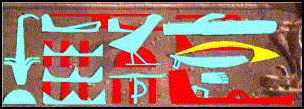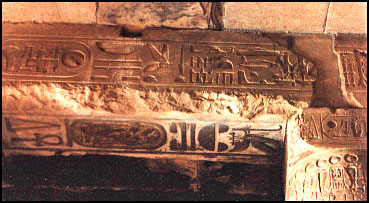|
from AncientArcheology Website
There are some very strange hieroglyphics in the Temple of Osiris at Abydos. According to many UFO enthusiasts and Atlantis proponents, these glyphs depict highly developed crafts, specifically a helicopter, a submarine, some form of flying saucer, and a jet plane. What are these inscriptions all about?
The glyphs,
unretouched. The glyphs are a result of both erosion of the stone surface (evident elsewhere in the temple) and the process of filling in and re-carving the stone to replace some of the original hieroglyphics. The technical term for such a surface that has been written on more than once is a palimpsest.
The usurping and modifying of inscriptions was common in ancient Egypt throughout its history. The Abydos glyph was modified at least once in antiquity, and perhaps twice. Some of the filling has fallen out in places where the older and the newer inscriptions overlap, and the result is unique and odd-looking.
Glyphs superimposed.
The text is part of the titulary of Ramesses II and can be translated as,
This replaces the royal titulary of Seti I that was originally carved into the stone. More technically, the actual "helicopter" seems to be a portion of the psd.t sign and the X3s.t sign on top of each other, with portions missing. An apparent change in scale also mucks things up.
The glyphs in
context. If the ancient Egyptians had vehicles such as helicopters, submarines, and jet airplanes, one would expect to find some evidence of this other than in a single inscription on the lintel of a single temple. This type of large machinery requires a vast amount of support (including fuel, parts, factories, etc.) but there is no trace of any such support in all of Egypt.
The Egyptian literature is also bereft of any boast, much less passing mention, of advanced aircraft. Obviously this situation doesn't seem peculiar to those who really want to believe that the ancient Egyptians flew around in airplanes.
The glyphs in situ.
|





